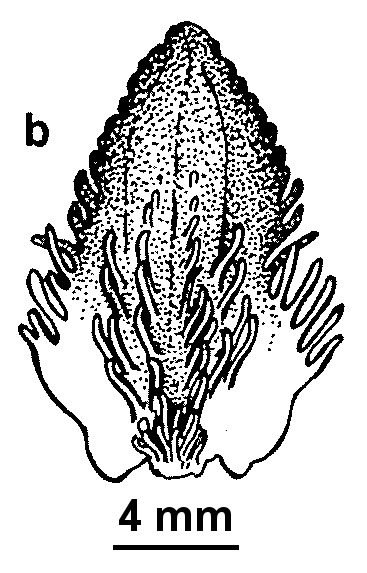Caladenia fitzgeraldii
RuppFlowering plant 12–20 cm tall. Leaf 6–10 cm long, 5–12 mm wide. Flower solitary; perianth segments 2–3 cm long, greenish cream with some pale red stripes; sepals 2–3 mm wide at base, tapered to filiform, clubbed tails, clubs 2–5 mm long, with dark red, globose to spherical, sessile glands which are mostly tightly packed and contiguous; lateral sepals divergent, stiffly deflexed; petals spreading to stiffly deflexed, shorter than sepals, flattened at base, tapered to an acuminate apex. Labellum curved forward with apex recurved and lateral lobes curved upwards, lamina broad-ovate to ovate-lanceolate, very obscurely 3-lobed, 11–13 mm long and 7–8 mm wide (when flattened), reddish distally, greenish cream towards the base; lateral lobes entire around curved base, then with marginal calli linear to triangular, mostly to 0.5 mm long, diminishing in size towards entire or slightly irregular mid-lobe; lamina calli in 4 rows, extending about half way to labellum apex, linear or foot-shaped, to 1 mm long at base of lamina, decreasing in size towards apex. Flowers Sep.–Oct.
EGL, EGU, HNF, VAlp. Also NSW. In Victoria, currently known with certainty only from the upper Cann River valley in tall eucalypt forest with a sparse understorey on well-drained light brown clay loam.
Caladenia fitzgeraldii is similar to, and could be confused with, a few other eastern species; see C. montana, C. peisleyi, C. osmera and C. australis. Victorian plants of C. fitzgeraldii have been treated as a distinct species, C. oreophila (D.L.Johnes) G.N.Backh., but Kosky (2021) has shown these to be conspecific.
 Spinning
SpinningKosky, W. (2021). East Gippsland’s Clubbed Spider Caladenia (Orchidaceae: Caladeniinae). Muelleria 40: 3–30.
